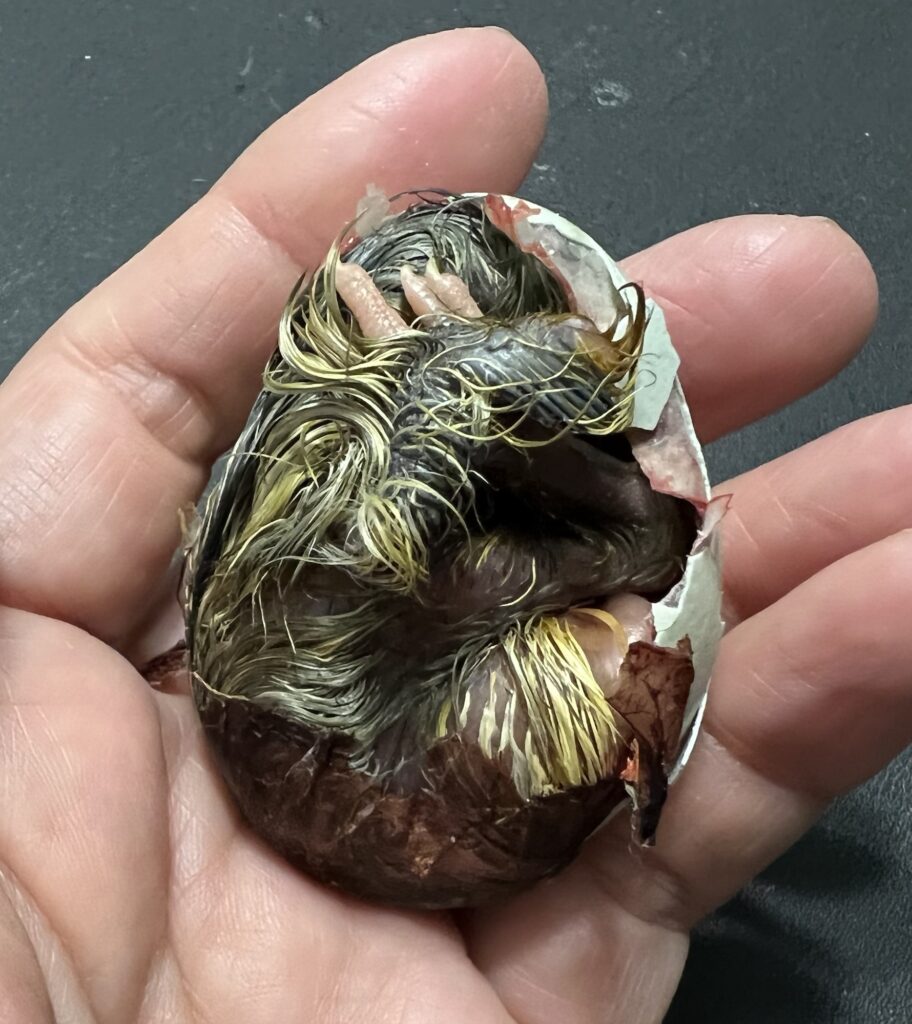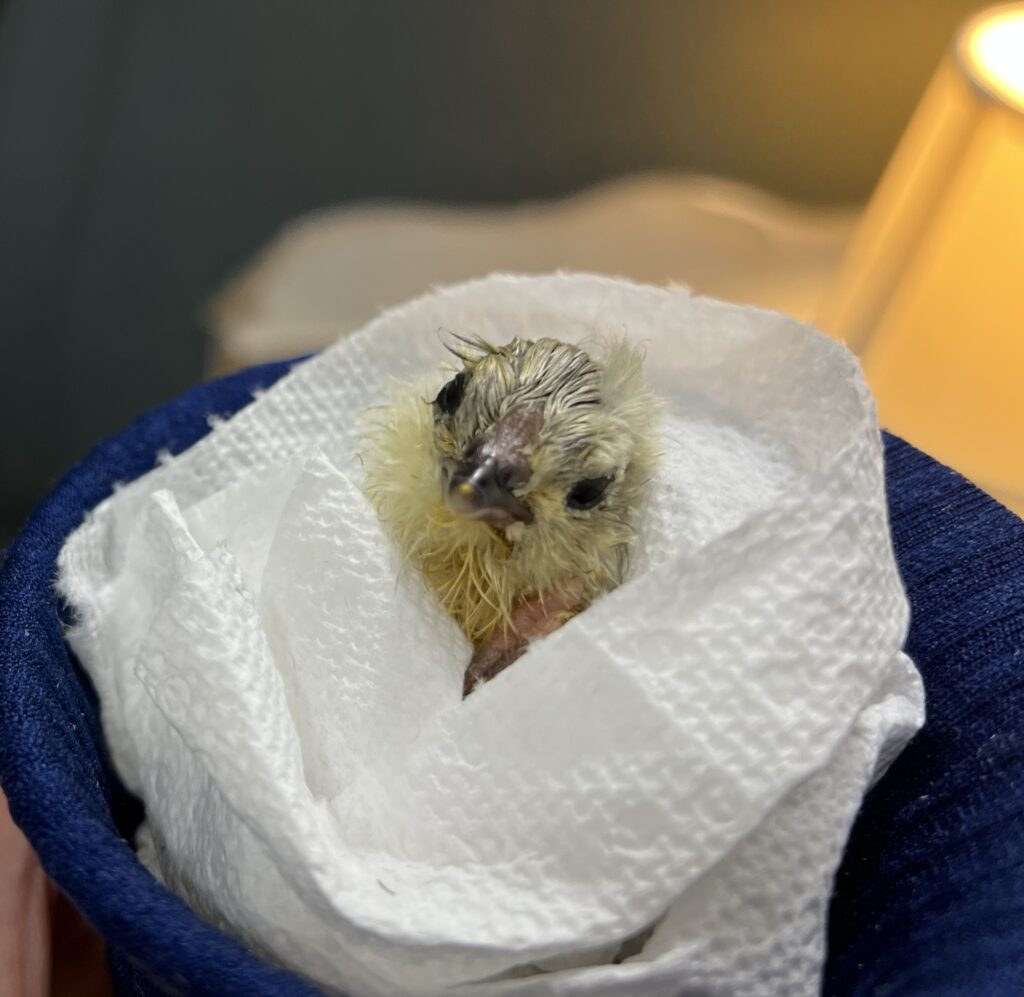
The first hatch of shipped eggs for the year is over, and it was a disappointing one. I started with 14 eggs (one cracked) and only 5 made it to lockdown. Did any even hatch?
The short answer is yes, but it was – once again – only one chick. And it was significantly assisted; in fact, I’m not sure this chick could have hatched on its own, given its malpositioning in the egg.
It’s been typical with the shipped eggs I’ve received in the past couple of years to have eggs begin to develop, but quit well before lockdown (day 18). That was also the case with these eggs; though their air cells didn’t look quite as mangled as some of the other eggs I’ve received, they had clearly been subjected to severe shipping stress. One was cracked, though I repaired it with Liquid Bandage.
The breeder had packed the eggs well: each egg was nestled into a spot in a specially-made foam egg shipper, surrounded by wadded newspaper for additional cushioning. So how in the world had the carrier (likely FedEx, as USPS doesn’t own its own fleet of jets, and this package was flown from the origin state) managed to slam the box around hard enough to crack one of the eggs enveloped by thick foam? It gives me a pretty good sense of just how rough that journey was, and why the hatch was almost a bust.

As day 21 approached, I looked for signs that the chicks were preparing to hatch: moving eggs, peeping from inside the shells, cracks or holes in the exterior of the egg (external pips). When I saw none of those indicators, I candled the eggs to check for signs of internal pips. None of the eggs were internally pipped, but there were signs of active blood vessels, so the chicks were still alive inside those eggs. Given that, I was somewhat reassured that they were still plugging along.
On day 22, there were still no signs of external pips, and candling showed no internal pips, either. Some of the eggs now looked like blood vessels were turning dark, though, which can indicate that the chick has died. I carefully made a small opening at the air cell to see if there were signs of life; I found that 3 of the 5 had already expired, and that they had not yet absorbed their yolk sacs. Two, however, still had chicks that were moving inside, and one had actually made a tiny hole in the membrane (so was internally pipped).
With eggs that have been opened, the membrane will tend to dry out more quickly than if the shell was intact, so I made sure that the humidity was high (over 60%) and applied coconut oil to the exposed membrane. The oil turns the membrane translucent, too, and allows easier evaluation of the state of the blood vessels. I could see that in both cases, the blood vessels were still active, and that yolk sacs needed to be absorbed.
The chick in the egg that had not internally pipped was very weak, barely moving even when I had gently pressed on the membrane to check for life; in fact, I had thought it was also a quitter until I saw the tiniest movement under the membrane. In my experience with shipped eggs in particular, this level of weakness has indicated chicks that are fading, and it was also true in this case; later that day, I found that the chick had died in shell.
With the passing of that chick, all hopes were pinned on the last egg. The chick in that egg had peeped a few times, and had managed to internally pip, but it was still not ready to hatch. I simply checked on it from time to time, applying coconut oil to keep the membrane flexible (and even when the oil dries, it makes the membrane easy to peel right off the chick) and ensuring that the humidity remained high. As the vessels began to dry up, I was able to very gradually push the membrane away from the chick’s beak and clear its head so that it could have unobstructed access to air.

During this time, the chick was absorbing its yolk. I could see some of it still in the bottom of the egg, so I knew it needed to stay in the egg until that yolk had drawn into its abdomen. With the membrane being moved away from its head, the chick began kicking its legs, so I placed the chick, still in the bottom half of its shell, in a cup. It would remain there until the yolk had absorbed and the danger of a yolk rupture had passed.
The next day, I checked on the cup chick and found that the yolk had been drawn into its abdomen, and that it had dried into the remains of its shell. I carefully removed the shell, taking extreme care around the navel area, which was still connected to the egg by a couple of strings of tissue (which I snipped with sterilized surgical scissors). I applied triple antibiotic ointment without pain reliever to the navel area and placed the chick – now crusty with dried membrane and fluids from the egg – back into the cup.

The chick was very weak, but its eyes were open, and it was moving, which gave me hope. It was a fighter. Because of its weakened state, I began offering diluted Nutri-Drench by cotton swab. I find that touching the soaked end of the swab to the side of the chick’s beak allows just a little to enter the mouth, and the chick will swallow it. After a couple of feedings of this liquid supplement, the chick was looking perkier.

Sadly, despite initially rallying and seeming to grow stronger, the little chick gradually began to fade, and I found her dead in her cup one morning. She lived for several days, but was very fragile: one of her eyes was partly closed most of the time (I treated it with Vetericyn Ophthalmic Ointment) and she had difficulty standing.
With her demise, the hope that she would become part of the breeding group here also died. And I think that may be the worst part: that there was, briefly, hope that she may overcome the obstacles that defeated the other chicks, who never hatched. At least I can take a small measure of comfort in knowing that – wherever she is – she is not suffering.
So what happened with this hatch? First and foremost, the shipping damaged the eggs. When the eggs began to develop, I could see that some had abnormal blood vessel development – it looked oddly tenuous and thready. Those eggs quit early. Others quit later in the incubation, but their rough start posed a major (and ultimately insurmountable) barrier to their development.
Though it seemed to help the damaged air cells resume a more normal appearance, I’m not convinced that manually turning the eggs three times a day was optimal. Turning the eggs frequently is most important in the early stages of embryo development, and I can’t help but wonder if the chicks would have fared better if I had put the incubator on the turning cradle. Based on my experiences incubating shipped eggs to date, for eggs that aren’t badly damaged upon receipt, I would stick with not turning the eggs for a few days, then put them on an autoturner to ensure that they are turned adquately. Despite running this hatch very dry, the eggs seemed to have retained more liquid inside them prior to hatch than I would expect, and I think the limited turning may have played a part.
Farming reality is that death happens. I struggle with the knowledge that, despite my best attempts, my vigilance, my exhaustive research, I can only do so much and, sometimes, it’s simply not enough. I know that sometimes chicks just die, but I have difficulty accepting that, as well as accepting that I will likely never really know why a chick like this one died. Some readers might be thinking that I should just “let Nature take its course” and not interfere in the hatching process. While I respect that stance, I wholeheartedly disagree with it: if I can save just one chick that would otherwise have died at the conclusion of artificial incubation (artificial being the operative word – arguably, this isn’t “natural” to begin with), it makes the negative parts of trying worthwhile; too, with each experience – good and bad – I am still learning, and it adds to my repository of knowledge about incubating eggs. As I’ve said many times, hatching is bittersweet.
Hatching shipped eggs has been both a learning experience and an exercise in disappointment. Of a total of 50 Lavender Ameraucana eggs received, I have just 3 2 surviving chicks, and their hatches were all difficult. Doing eggtopsies and finding fully-formed chicks that looked ready to hatch but died without pipping is something I just don’t get used to, but is part of incubating shipped eggs now. It seems that the days of ordering shipped eggs and having even a 50% hatch rate are over unless luck is truly smiling upon you.
